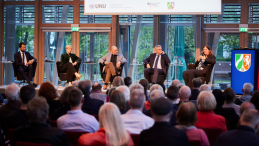On 12 December 2022, UNU-IAS contributed to two sessions of the Nature and Culture Summit held as part of the UN Biodiversity Conference (CBD COP15) in Montreal.
The first session, “Actions on Science and Knowledge Dialogue, and Biocultural Indicators”, discussed the importance of promoting exchanges between scientific and traditional knowledge systems, values, experiences, methods, and results relevant for the conservation and sustainable use of biological diversity.
Panellists highlighted that nature, culture, health, and human rights were interconnected. The global biodiversity crisis is also a human rights crisis that mainly affects the most vulnerable and marginalised populations. It was stressed that human-rights based approaches should be integrated into the implementation of the post-2020 global biodiversity framework (GBF) to catalyse transformative change, ensure accountability, and engage indigenous peoples and local communities (IPLCS). As nature preservation is woven into the culture of IPLCS — including songs, stories, and dances — the speakers concluded that art could help to make science more understandable and relatable.
Suneetha Subramanian (Research Fellow, UNU-IAS) spoke about her experiences as an author of the IPBES Assessment Report on the Diverse Values and Valuation of Nature, highlighting that views and understanding of nature affect how we interact with it. It is crucial to consider multiple perspectives to create harmonious relationships between societies and nature.
The second session, “New Approaches to Communication, Education and Public Awareness”, explored inspirational action to raise awareness of the interlinkages between biological and cultural diversity across all sectors.
The discussion focused on how to create a culture of conservation and care for nature through communication and education. Participants noted that communicating the multiple values of biodiversity was crucial for the GBF; however, more discussion was needed at the local level to shift behaviours. Since many IPLCs do not have access to traditional communication channels, informational materials must be adapted to reach them.
Maiko Nishi (Research Fellow, UNU-IAS) introduced the Toolkit for the Indicators of Resilience in Socio-ecological Production Landscapes and Seascapes (SEPLS), aimed at helping local communities better understand their strengths and weaknesses, and develop strategies for improving resilience. The process is designed to be participatory to ensure the involvement of all stakeholders, ranging from IPLCS to NGOs and governments, making the indicators a communication tool within and beyond local communities to promote adaptive and sustainable co-management of biodiversity.



![smart2[1].png](https://unu.edu/sites/default/files/styles/card_view_small/public/2024-04/smart2%5B1%5D.png?itok=_-ZcLOM5)